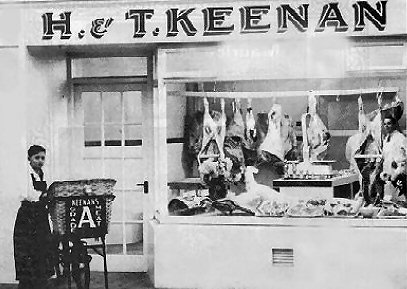Northern Ireland’s post-War housing stock was worse than that of any other part of the United Kingdom, despite having been spared the worst of the German blitz. Most houses had been built before the First World War and they were grossly inadequate in quantity as well as in quality. In England the newly elected Labour Government was determined to make amends to the working class heroes who had saved the country from fascism. It quickly introduced the Welfare State and embarked on an ambitious house-building programme. The Education Acts (1944 in England, 1947 in Northern Ireland) opened up free secondary education to the baby-boom generation.
In all social reform legislation, the ultra conservative Unionist Government at Stormont dragged its heels, eventually succumbing to reform for fear of more direct political intervention in all its affairs. A new body, the Northern Ireland Housing Trust was given the task constructing these homes. The first of the grandly-termed housing estates in Newry was situated on the western end of the town on what had been Rooney’s Meadow.
Newry Urban Council was proud of its achievements over the previous decades, having built homes for the working class at O’Neill’s Avenue, Erskine Street and Pound Street to name but a few, but this did not even begin to address the demand. Some 20% of all the town’s approximate 15000 citizens were on the housing list. Even the most recently constructed homes were beyond people’s means, were located within the inadequate town boundaries, were bereft of such necessary facilities as bathrooms and even in some cases inside toilets, were much too small for families and had no open play spaces near them.
Stormont especially frowned upon house building in predominantly nationalist areas such as Newry. Even the Urban Council was blighted by this sectarian attitude. Through to the 1960s house allocation remained one of the local council’s powers. If you wanted a house, you made personal representation to your local Councillor. There were four electoral wards in the town, the North Ward being predominantly Unionist. Some 25% of all new housing stock was in the gift of Councillors representing little more than half that percentage of constituents, who naturally favoured their own people first.
This fact is often quoted as evidence of the enduring magnanimity of Newry’s nationalist councillors, and indeed of Unionists, who by this artificial device had more homes to allocate than Protestant constituents to occupy them! At its best, the policy was a perverse form of reverse discrimination; at worst, it was evidence of moral cowardice. Certainly generations of large Catholic families, forced to endure further decades of gross over-crowding in cramped town housing, some parents raising a whole family in a single room, had little cause to celebrate.
On the positive side, the policy ensured that the residents of the new estate were well mixed in religious terms. For half its subsequent life, the mix worked well and few complaints were heard or incidents recorded. Unfortunately when our recent Troubles reached their height, a number of Protestants relocated to other parts where they felt more secure. Even at the start, there were many more Catholic families, but Protestant families were represented initially beyond their natural numbers in this overwhelmingly nationalist West End of Newry.
Curiously (or maybe not) these Protestant families were usually allocated homes in close proximity to one another. By and large they tended to gravitate towards one another and social contact across the religious divide was restricted. Subsequent decades have shown that mixed marriages were the exception here as elsewhere in Northern Ireland.
That first generation of meadow residents lived through a time of relative political and inter-community stability. The great majority of Meadow families lived side by side in peace and harmony. The few ‘mixed’ marriages – in Northern Ireland a quaint if unwholesome term for couples marrying across the Christian divide – generally worked at least as well as others, as many who followed the example of their parents into the next generation will testify. This is a tribute to the couples concerned as much as to the general good sense of the Newry people who, by and large, have throughout the most divisive of times, demonstrated a cross-community tolerance which is the envy of others.
… Building ball-bearing Buggies ? …
